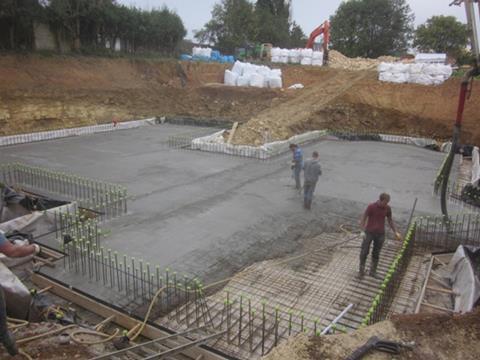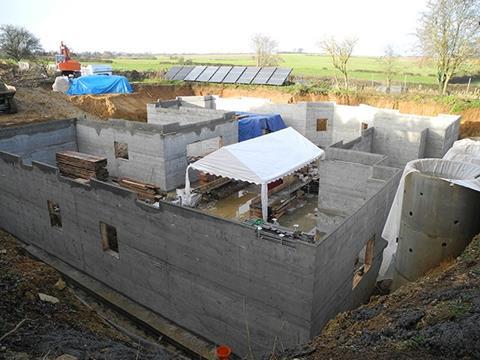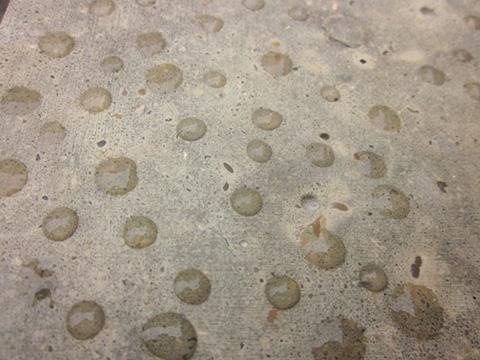Concrete is comprised of aggregate of different sizes, cement and water. This module, sponsored by Waterproof Concrete with Site Supervision, examines the benefits of reducing water content in concrete

How to take this module
UBM’s CPD distance-learning programme is open to anyone seeking to develop their knowledge and skills. Each module also offers members of professional institutions an opportunity to earn between 30 and 90 minutes of credits towards their annual CPD requirement.
This article is accredited by the CPD Certification Service. To earn CPD credits, read the article and then click the link below to complete your details and answer the questions. You will receive your results instantly, and if all the questions are correctly answered, you will be able to download your CPD certificate straight away.
CPD CREDITS: 60 MINUTES
DEADLINE: 7 NOVEMBER 2014

INTRODUCTION
Concrete is comprised of aggregate of different sizes, cement and water, with cement substitute and chemicals such as water-reducing admixtures (plasticisers) often added. The proportions of these ingredients can vary widely, affecting the concrete’s performance characteristics.
Concrete is inherently water-resistant, so it is an ideal construction material for structures such as basements and bridges. However, variations in the mix of ingredients can affect the degree of water resistance and porosity of the concrete. Concrete with a low water/cement ratio has an extensive network of “capillary pores” – essentially small, connected gaps between the cement crystals that are full of water. With a higher water/cement ratio, the concrete will become more porous. With a considerable excess of water, a vacuum can be created within the concrete as it dries out, which can lead to shrinkage and cracking.
Much research has therefore been carried out to reduce the water content of concrete. A solution that is used widely throughout Japan, South Korea and China involves the use of a powerful “PCE superplasticiser”, which makes the concrete workable using lower proportions of water and allows it to form a compact, non-porous structure that is fully waterproof since the capillaries are closed off from one another. This approach was developed in Japan in the 1990s but has only recently emerged in the UK.
This CPD examines the benefits of reducing water content in concrete, explaining how waterproof concrete works and how it performs in comparison with other standard types of concrete that use plasticisers.

THE IMPORTANCE OF THE WATER-CEMENT RATIO
Water is a vital ingredient of concrete. Concrete hardens as a result of the chemical reaction between cement and water, known as hydration. The cement and water create a gel, from which tightly interlocking crystals of concrete are formed. Theoretically, a water-cement ratio of 0.38 is needed to complete the reaction – in other words, for every 1kg of cement, about 0.38l (or 0.38kg) of water would react with it. In practice, as the concrete sets, the water cannot move freely through the mixture to find the remaining grains of cement, and so additional water is needed to form the gel.
More water also needs to be added to make the mix workable. Because the grains of cement are jagged rather than smooth in shape, the water helps to push them apart and allows them to flow more readily. Normal readymix with a lignene-based WRA plasticiser contains about 55% water to a blend of cement and fly ash, which gives the concrete the workability – or “consistence” – needed to place it.
The problem is that in increasing the concrete’s workability with water, its strength is reduced and more water is left over after curing. The water pushes the cement grains apart, reducing the ability of the crystals to interlock during hydration. More cement is needed to achieve the target strength and the water is increased in the same proportion. On some sites more water still may be added by the workforce to make the concrete flow, weakening it further.
The other problem is that the higher the water-cement ratio, the more water will remain in the cured concrete, increasing porosity. Only with a maximum water-cement ratio of about 0.45 will the cement eventually run out of space during the concrete’s curing process. This is because, as the cement absorbs water, it increases in volume by 120%. When it has nowhere left to expand, the remaining water remains in unconnected pores.
If the water-cement ratio is higher than 0.50, the left-over water-filled pores will be connected, leaving a network of capillary pores. A recent Concrete Society report noted: “Capillary pores are present as a result of the excess water added to the concrete to provide adequate consistence … The less excess water used in manufacture of the concrete, the smaller and more discontinuous the capillaries in the hardened concrete, with a consequential reduction in permeability and absorption.”
If the water-cement ratio is higher than 0.60, this increases the risk of shrinkage and cracking as the concrete dries. It also greatly reduces the protection to the concrete’s reinforcing steel, as deleterious chemicals that can attack steel (such as road salt and oxygen) need to be dissolved in water to do so, and water can enter the concrete easily.
Research carried out in the late 1980s indicated that these problems could be avoided in concrete with a water-cement ratio lower than 0.50 as this would ensure “capillary discontinuity” – in other words, the network of capillaries would be broken, eliminating the ability of water to pass through the concrete and making it fully waterproof. However, to create concrete with such a low water content, that would still be workable when delivered to site, would require a very powerful plasticiser – an additive that enables the jagged grains of cement to flow freely around one another, aiding workability and improving compaction. At the time, no such product existed.
However, in the 1990s a PCE superplasticiser was developed in Japan using a polycarboxylate ether long chain molecule. One such product has been shown to deliver workable concrete with a water-cement ratio of 0.45 and is now used in over 1 billion cubic metres of concrete annually. The next section will examine how it works.

WATERPROOF CONCRETE VS C35 VS C35A
Below is a comparison of the structure and performance of standard C35 and C35A mixes and with a waterproof concrete using the PCE superplasticiser. The waterproof concrete and C35A are a CEM 1 type, which means they contains only ordinary Portland cement (OPC), while the C35 mix is CEM2, with 25-35% of the OPC replaced with fly ash.
1. Waterproof concrete
The waterproof concrete has a water-cement ratio of 0.45, and a cubic metre might have 950kg of stones, 1,000kg of sand, 350kg of OPC and 157.5l of water. This totals 2,457.5kg and any air is removed during thorough compaction.
In this mix, the additional sand completely fills the spaces between the stones and the additional cement completely fills the spaces between the sand. Although there is more water than the chemical reaction requires, it only coats each grain of cement – it does not push them apart. The PCE superplasticiser gives the consistency needed to enable the concrete to be placed and compacted easily.
After the concrete is in place, the surfaces of the cement grains mix with the water coating them, beginning the hydration process: gel is formed, this expands and is forced to mix with gel from the next grain, as well as sand and aggregate. Hours later, the gel turns to crystals. The crystals do not require all of the water within the gel, so water is now released. This mixes with the new surface of the cement, repeating the crystallisation process, and thickening the skeleton of crystals throughout the concrete. This process can only continue while there is space. After only a few days, the rate of change from cement and water to crystals of concrete is far slower because the remaining water cannot easily get through the tightly packed crystals already formed. The concrete is already completely waterproof.
Within a few more weeks, there is no space for any movement at all. It is impossible for water molecules to get through to remaining grains of cement. The last gel to form crystals will always release water, so there will always be free water left inside concrete, but in fully waterproof concrete it is trapped.
Even if the concrete were to crack, allowing the remaining water to reach relics of cement grains, the result would be that gel would form and turn into crystals, and the concrete would self-heal. This is known as autogenous healing (subject to the specification of enough steel reinforcement to control crack widths sufficiently).
2. C35
The C35 mix has a water-cement ratio of 0.55, and a cubic metre might comprise of 950kg of stones, 900kg of sharp sand, 200kg of blended cement, 110l of water (which is actually less by volume than in the waterproof concrete) and a small amount of WRA. This totals 2,260kg, and some air will complete the cubic metre.
This mix has less sand and cement to fill the space between the stones, and a higher proportion of water filling these spaces and pushing the cement grains apart. This means that when the cement begins to gel with water, a greater proportion gels at once because there is more water available for each grain and more space for gel to form. With so much space available, the first gel from one grain barely mixes with the first gel from the neighbouring grain. Crystals form but they do not intertwine or form a continuous skeleton until much later.
The use of fly ash in place of some cement adds workability (because the smaller fly ash grains are spherical), giving more time to place and compact the concrete properly, which allows the water to be reduced slightly. However, fly ash is virtually inert in concrete, so water-filled spaces between fly ash grains will become capillary pores. Using fly ash also pushes up the water-OPC ratio.
In terms of porosity, even though the C35 is quite dense, water may still be pushed through under pressure and pulled in by the interconnected capillaries.
C35A
C35A is a mix design contained within BS 8007:1987 “Code of practice for design of concrete structures for retaining aqueous liquids” (this has subsequently been superseded by BS EN 1992-3:2006, or Eurocode 2). This is a concrete of structural strength that will not allow any visible sign of water through (the “A” stands for aqueous). The mix is for use in structures that will retain aqueous liquids, such as sewage treatment plants and water purification plants. It relies on some extra sand, some extra cement and a little less water than C35.
Although C35A is dense enough to prevent water visibly leaking, the water-cement ratio would still be 0.55 when OPC is specified without fly ash. So it still has capillary pores.
BS 8007 classified C35A as “watertight” rather than waterproof.

TESTING AND CERTIFICATION
OPC concrete using the PCE superplasticiser has been tested to BS EN 12390-8:2009 by UKAS accredited laboratories. One test on concrete used to form a basement floor slab in Streatley, Berkshire used a 150mm x 150mm x 150mm cube of P400 CEM 1 concrete with 500ml of the PCE superplasticiser, marketed in the UK as Triple Proof. The sample had a water-cement ratio of 0.45 and had been cured for 28 days.
The tests showed that, after 96 hours of water under 4 bar of pressure, there was 0mm penetration into the concrete. Strength tests indicated a compressive strength of 52.9N/mm2.
A second test on concrete used for a basement floor slab in Redditch using P350 CEM 1 concrete and Triple Proof powder instead of liquid again showed 0mm of water penetration and compressive strength of 58.7N/mm2.


How to take this module
UBM’s CPD distance-learning programme is open to anyone seeking to develop their knowledge and skills. Each module also offers members of professional institutions an opportunity to earn between 30 and 90 minutes of credits towards their annual CPD requirement.
This article is accredited by the CPD Certification Service. To earn CPD credits, read the article and then click the link below to complete your details and answer the questions. You will receive your results instantly, and if all the questions are correctly answered, you will be able to download your CPD certificate straight away.
CPD CREDITS: 60 MINUTES
DEADLINE: 7 NOVEMBER 2014.
Privacy policy
Information you supply to UBM Information Ltd may be used for publication and also to provide you with information about our products or services in the form of direct marketing by email, telephone, fax or post. Information may also be made available to third parties. UBM Information Ltd may send updates about ��ɫ����TV CPD and other relevant UBM products and services. By providing your email address you consent to being contacted by email by UBM Information Ltd or other third parties. If at any time you no longer wish to receive anything from UBM Information Ltd or to have your data made available to third parties, contact the Data Protection Coordinator, UBM Information Ltd, FREEPOST LON 15637, Tonbridge, TN9 1BR, Freephone 0800 279 0357 or email ubmidpa@ubm.com. View our full privacy policy at






















No comments yet